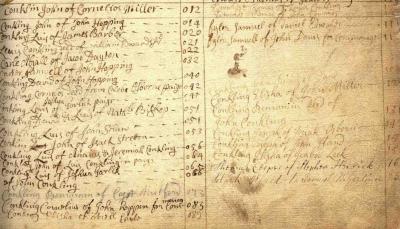‘Win-Win’ For Town, Library

“It is no crime to kill a person here with a motor,” Ruth Gordon Stratton of East Hampton wrote home in 1917 from war-torn France, where she was helping to run a Red Cross field station. “They only arrest the corpse for obstructing the traffic but to run over a dog is a terrible thing . . .”
The passage is from a hitherto unknown letter, part of a 97-year-old collection called “East Hampton in World War I.” As of this week, its poignant accounts of the brutal “war to end all wars,” written by young soldiers and nurses who grew up on the tranquil South Fork, can be read with just a few clicks on a computer, thanks to the East Hampton Town Historic Records Project, a collaboration between the town and the East Hampton Library’s Long Island Collection that has scanned and preserved a trove of rare archival materials.
The project — covering the years 1649 to the mid-1950s and including many functions of town government, from minutes of ancient trustee meetings to “records of overseers of the poor,” “notices to become citizens,” “enrollment of persons liable to military duty 1864,” even chronicles of cattle earmarks — began with mold.
In January 2015 there was a serious mold outbreak in the old Town Hall. “Larry Cantwell told me that all the town’s archives were there,” recalled Steve Boerner, a Long Island Collection archivist. “Carole [Brennan, the town clerk] and I quarantined everything. We got a document-remediation company to come in and they fumigated and cleaned up. We wrapped some stuff in Saran Wrap and stored it in the new building.”
Town Supervisor Cantwell and Ms. Brennan agreed with Mr. Boerner that “protective action,” as Andrea Meyer, another Long Island Collection archivist, put it, should be taken. The oldest, moldiest, and most fragile materials were sent to the temperature-controlled Long Island Collection, on loan from the town, to be digitized and catalogued.
“I will get them back when I have a safe place to store them,” Ms. Brennan said Tuesday. “I like to sleep at night.”
The library is paying for the scanning, which took Mr. Boerner and Ms. Meyer, assisted by Lexie D’Attile and Sara Spataro, a little over two years. At the beginning, Ms. Meyer said, “We had to figure out what we even had here.”
Much of the material scanned — the records of town trustee meetings, for example — already existed in book form. But among the crumbling piles, said Mr. Boerner, “I identified three volumes that have never been published, manuscript volumes containing significant material.” Even one unpublished colonial document “could be vital to our understanding of our history here,” he said. “If it was never published, then the information in it is brand-new.”
He estimated that 95 percent of “what’s possibly out there” has now been digitized. “It’s a win-win situation,” Mr. Boerner said.
It surely is. The town preserves irreplaceable history, the Long Island Collection augments its already impressive reputation as a destination for professional and amateur researchers, scholars, historians, and students of local genealogy, and the public has a new website to get lost in on a rainy day.
Click on easthamptonlibrary.org/long-island-history/digital-long-island, then click East Hampton Town Historic Records.
Separately, the town has embarked on its own scanning project, which will eventually make most of its records of interest to the public available online. Becky Rahn, the receiver of taxes, said her department’s records are almost all there already. Ann Glennon, who heads the Building Department, said she has about 15,000 building permits remaining to be scanned out of 60,000, going back to 1957, when zoning was enacted.
“They started with my department because I had the oldest files,” Ms. Glennon said. “They began in 2015, then there was a lull, now they’re going full steam . . . this project is awesome.”
